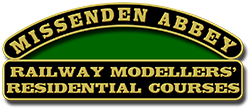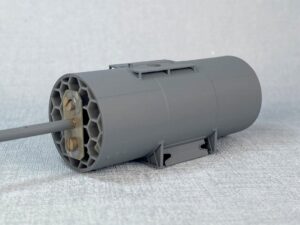The advent of cheaply available 3D printers in the home and the growing number of bureaux offering 3D printing services has meant that in recent years more and more modellers are adding 3D printing to their toolbox of modelling techniques. Many start by buying 3D printed components or downloading freely available 3D designs, however to really benefit from the technology you need to design your own models or components for printing. 3D printing not only gives the option to design complete models, but also those difficult to get detailing components to add to ready to run items or to augment traditionally produced models. You can also print jigs and guides to help you when building using more traditional modelling methods.
 A multi-media wagon built from a plastic kit with brass under frame and scratch built load supports. The loads are 3D printed and a selection of the 3D printed components & jigs used to build the wagon are shown in the foreground.
A multi-media wagon built from a plastic kit with brass under frame and scratch built load supports. The loads are 3D printed and a selection of the 3D printed components & jigs used to build the wagon are shown in the foreground.
 A 009 wagon entirely printed, with the exception of the wheels and couplings, on a home FDM 3D printer. The wagon was printed as a kit with separate floor, sides and chassis and then glued together.
A 009 wagon entirely printed, with the exception of the wheels and couplings, on a home FDM 3D printer. The wagon was printed as a kit with separate floor, sides and chassis and then glued together.
 A chassis for a 4mm Simplex Tractor. The body is a 3D printed item from Shapeways whilst the chassis itself is printed on a home FDM 3D printer. A 6mm motor and gearbox is used driving via some off the shelf gears to a set of wagon wheels.
A chassis for a 4mm Simplex Tractor. The body is a 3D printed item from Shapeways whilst the chassis itself is printed on a home FDM 3D printer. A 6mm motor and gearbox is used driving via some off the shelf gears to a set of wagon wheels.
 A motor mount and gear housing for a 4mm Colonel Stephens Ford Railbus. Printed on a home FDM printer, in this case a Prusa Mini.
A motor mount and gear housing for a 4mm Colonel Stephens Ford Railbus. Printed on a home FDM printer, in this case a Prusa Mini.
The mount utilises a 6mm motor with planetary gearbox and off the shelf gears.
 A screenshot from Fusion 360 of a RCH 18" 4 rib buffer.
A screenshot from Fusion 360 of a RCH 18" 4 rib buffer.
This is an example that you will learn how to draw as part of your course.
 A selection of coupling height jigs, buffer beam slot guides and a NEM pocket for 009 and OO rolling stock.
A selection of coupling height jigs, buffer beam slot guides and a NEM pocket for 009 and OO rolling stock.
Printed on a Prusa FDM printer.
In this course you will be tutored on one of the best tools for creating your own 3D models, Fusion 360 from Autodesk. This is a professional drawing tool but available free of charge for personal use. Your tutor for this course is Justin Newitt of Rumney Models. Justin will take you through the principles of Fusion 360 and assist you to create a 3D model that you can either print on your own machine or send to a printing bureau. At first sight a 3D drawing package can seem daunting to use, but Justin will use his years of experience with the package to guide you through the things you need to know and to help you avoid the pitfalls for the unwary.
The only way to truly learn a tool like Fusion 360 is by using it, therefore the course takes a very hands-on approach to teaching you the ways you can use the tool to create those items you need to enhance your modelling. You may not go home with a physical model in your hands, but you will have the tools to create your own designs to print by the end of the weekend.
The course will also include a discussion of the different types of 3D printing, their relevance to railway modelling and how to design specifically for them. It will also look at various techniques involved with producing 3D prints at home, including the process of slicing, what it does, why it is necessary and how the likes of supports, rafts and other printing controls can effect your final print.




